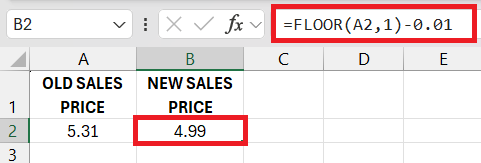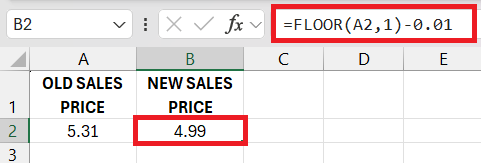

Key Takeaways:
- Basics of Rounding in Excel: Learn how to round numbers to the desired precision using functions like ROUND, ROUNDUP, and ROUNDDOWN.
- Precision Control with ROUND Function: Understand how to utilize the ROUND function for precise control over numerical data.
- Specialized Rounding Needs: Explore alternative rounding functions like MROUND, CEILING, and FLOOR for specific rounding requirements.
- Difference Between Rounding and Formatting: Beware of the distinction between rounding and formatting numbers in Excel to ensure accurate data manipulation.
Table of Contents
Navigating the World of Excel Rounding
Why Precision Matters in Financial and Data Analysis
In the meticulous world of financial and data analysis, precision isn’t just a preference—it’s a necessity. Handling numerical data with care ensures that your insights and conclusions are based on accurate and reliable figures.
Inaccuracies may not only skew your results but can significantly impact decision-making. Whether you’re managing budgets, forecasting sales, or analyzing numerical trends, rounding numbers play a crucial role in presenting data that is easy to understand and work with.
The Basics of Rounding Numbers in Excel
Getting your numbers to reflect the right level of precision is a cornerstone skill in Excel. In essence, you might find yourself needing to round a figure to the nearest whole number or to a specific number of decimal places for clarity or to meet certain standards. Excel offers different methods to accomplish this, each with its nuances.
For a start, the ‘ROUND’ function is especially popular, allowing you to specify exactly how many decimal places you want to round your numbers to.
But using the ‘Format Cell‘ method to display a rounded figure without changing the actual cell value, or make use of the rounding buttons for quick adjustments is not actual rounding up or down a number but just a change in formatting.
Mastering Single Decimal Place Round Offs
Utilizing the ROUND Function for Precision Control
Harnessing the power of the ROUND function in Excel gives you precision control over your numerical data. This function is beautifully straightforward: you simply decide how many decimal places you want to round your number to, and it handles the rest. For instance, if you’re rounding to one decimal place, you frame your formula like =ROUND(A1, 1). Here, A1 represents the cell containing your number, and the 1 indicates the single decimal place you’re targeting.
This function is an invaluable asset when consistency in data precision is required, such as when presenting financial statements or analyzing statistical data.
The ROUNDUP and ROUNDDOWN Variants for Specific Needs
Sometimes you have specific rounding requirements that the standard ROUND function might not meet. That’s where the ROUNDUP and ROUNDDOWN functions step in. They are particularly useful when you want to ensure that your numbers always round in a given direction, regardless of their value. ROUNDUP pushes your figure to the next highest number at the specified decimal place, while ROUNDDOWN will always move it towards the next lowest.
Imagine you’re fine-tuning a budget and want to err on the side of caution by rounding expenses up to the One (1) decimal place. The ROUNDUP function is your friend here.
Conversely, when maximizing profit predictions, you could use ROUNDDOWN to maintain conservative figures.
Both functions use the same format as ROUND, simply =ROUNDUP(number, num_digits) or =ROUNDDOWN(number, num_digits), making them equally easy to apply.
Exploring Alternative Rounding Functions
When to Leverage MROUND, CEILING, and FLOOR Functions
The MROUND, CEILING, and FLOOR functions are specialized tools in your Excel arsenal designed for instances when standard rounding doesn’t fit the bill.
MROUND comes in handy when you want to round a number to the nearest specified multiple, which is perfect for situations where values need to conform to predetermined increments, for example if you want to round up a number to nearest multiple of 5.
The CEILING function steps up when you need to round a number up to the nearest specified multiple. It’s used extensively in pricing strategies to ensure prices are aligned with psychological pricing points, like $0.99 or $0.95.
As for the FLOOR function, think of it as the counterpart to CEILING; it rounds down instead of up. This is particularly useful in manufacturing, where materials may need to be ordered in specific batch sizes to minimize waste.
Remember, each of these functions requires two arguments: the number you are rounding and the multiple to which you are rounding it. For smooth operation, ensure the multiple is of the same sign as the number you’re rounding.
The Differences Between Rounding and Formatting Numbers
Beware the subtle yet significant distinction between rounding and formatting numbers in Excel. They may seem similar, but they play very different roles. Formatting alters the appearance of a number, making it look rounded without actually changing its underlying value in the cell. On the other hand, rounding functions like ROUND, ROUNDUP, and ROUNDDOWN modify the actual data, potentially affecting calculations and outcomes.
Suppose you format a number to show no decimal places for a sleeker look; while it appears as a whole number, Excel retains the original decimal value for any computations. Contrast that with rounding, where the result impacts the precision and could influence sums, averages, and other aggregated data.
The key is to use formatting for purely aesthetic adjustments and rounding when precise data manipulation is required.
Step-by-Step Guides for Rounding Scenarios
Rounding Prices to End in .99 for Retail Optimizations
Rounding prices to end in .99, sometimes referred to as “charm pricing,” is a well-known retail strategy. This method can steer consumer perception, making a price seem more attractive or affordable. If you’re handling a spreadsheet full of prices in Excel that need to be adjusted to end in .99, you can employ a simple formula: =FLOOR(A2, 1)-0.01. This formula rounds the price down to the nearest dollar and subtracts one cent, turning, for instance, $5.31 into $4.99.
Adjusting Values to the Nearest 1000 in Large Datasets
Adjusting values to the nearest 1000 in extensive datasets is essential when you want to streamline figures for reporting or when dealing with very large numbers, such as total annual revenue or population sizes. In Excel, this can be done with the ROUNDUP, ROUNDDOWN, or ROUND functions, depending on whether you want to round up, round down, or to the nearest 1000, respectively. For example, =ROUND(A1, -3) would round the value in cell A1 to the nearest thousand.

FAQs: All About Excel Rounding at One Decimal Place
How do you round to one decimal place in Excel?
To round to one decimal place in Excel, you can use the ROUND function with a formula like =ROUND(A1, 1) where A1 is the cell containing the number you want to round. The ‘1’ specifies that the number should be rounded to one decimal place. This will ensure your number is rounded to the nearest tenth.
How to Round Up to the Nearest Tenth Every Time?
To always round up to the nearest tenth in Excel, use the ROUNDUP function. The formula goes like =ROUNDUP(A1, 1). Here ‘A1’ is your targeted cell, and ‘1’ mandates the rounding to one decimal place upward, regardless of the next digit.
Can You Perform Conditional Rounding Based on Certain Criteria?
Yes, you can perform conditional rounding in Excel by pairing the ROUND function with IF statements. Create a formula with your specific criteria that tells Excel when and how to round a number, such as =IF(A1 > 100, ROUND(A1, 0), ROUND(A1, 1)). This rounds values over 100 to no decimal places and others to one decimal place.
Is There a Quick Method for Rounding Entire Columns to One Decimal?
Yes, to quickly round an entire column to one decimal in Excel, you can input the ROUND function into a cell adjacent to your data and then drag the fill handle down to copy the formula to the rest of the cells. For instance, if your numbers are in column A, you would enter =ROUND(A1, 1) in cell B1 and then drag down.
How Do I Ensure Consistent Rounding Across Different Versions of Excel?
To ensure consistent rounding across different Excel versions, always use the built-in ROUND function or its variants like ROUNDUP and ROUNDDOWN. These functions behave reliably across Excel versions. Ensure all users apply the same function and decimal place argument to maintain uniformity in your data.
John Michaloudis is a former accountant and finance analyst at General Electric, a Microsoft MVP since 2020, an Amazon #1 bestselling author of 4 Microsoft Excel books and teacher of Microsoft Excel & Office over at his flagship MyExcelOnline Academy Online Course.













